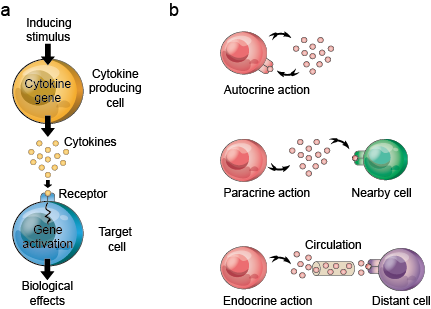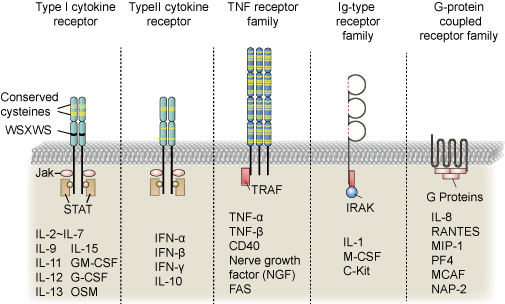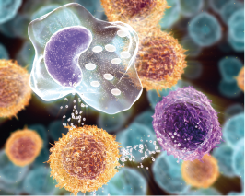Cytokines are low-molecular weight regulatory proteins or glycoproteins secreted by immune cells (monocyte, macrophage, T lymphocyte, B lymphocyte, Nature killing cells etc.) and various other cells (endotheliocyte, epithelial cells, fibroblast etc.) in the body in response to a number of stimuli. These proteins assist in regulating the development of immune effector cells, and some cytokines possess direct effector functions of their own (Figure 1a).
A particular cytokine may bind to receptors on the membrane of the same cell that secreted it, exerting autocrine action; it may bind to receptors on a target cell in close proximity to the producer cell, exerting paracrine action; in a few cases, it may bind to target cells in distant parts of the body, exerting endocrine action (Figure 1b).

Figure 1. (a) Expression of cytokines and their receptors is highly regulated; (b) Cytokines can act in Autocrine (same cell), Paracrine (close proximity) and Endocrine (long distance) ways.
Cytokines exhibit the attributes of pleiotropy, redundancy, synergy, antagonism, and cascade induction.
- A given cytokine that has different biological effects on different target cells has a pleiotropic action.
- Two or more cytokines that mediate similar functions are said to be redundant; redundancy makes it difficult to ascribe a particular activity to a single cytokine.
- Cytokine synergism occurs when the combined effect of two cytokines on cellular activity is greater than the additive effects of the individual cytokines.
- In some cases, cytokines exhibit antagonism; that is, the effects of one cytokine inhibit or offset the effects of another cytokine.
- Cascade induction occurs when the action of one cytokine on a target cell induces that cell to produce one or more other cytokines, which in turn may induce other target cells to produce other cytokines.
There are more than 200 different kinds of cytokines have been found so far. Cytokines generally have a molecular mass of less than 30kDa. Structural studies have shown that the cytokines may characterized belong to one of four groups: the hematopoietin family, the interferon family, the chemokine family, or the tumor necrosis factor family. According to the main function, cytokines may also be classified as: interleukin (IL), interferon (IFN), tumor necrosis factor (TNF), colony stimulating factor (CSF), growth factor (GF) and chemokine.
Interleukins (IL) are a group of cytokines that were first seen to be expressed by leukocytes. The term interleukin describes a variety of polypeptides that act specifically as mediators between leucocytes. However, the name interleukin is something of a relic, since it has been found that interleukins are produced by a wide variety of body cells.
Interferons (IFN) are named after their ability to “interfere” with viral replication within host cells. Normally, interferon mediate a continual conversation between cells about growth and defenses.
Tumor necrosis factors (TNF family) refer to a group of cytokines which are mainly secreted by macrophages and can induce cell death of certain tumor cell lines.
Colony-stimulating factors (CSFs) are secreted glycoproteins that bind to receptor proteins on the surfaces of hemopoietic stem cells, thereby activating intracellular signaling pathways that can cause the cells to proliferate and differentiate into a specific kind of blood cell.
Growth factors (GF), which generally considered as a subset of cytokines, refer to the diffusible signaling proteins that stimulate cell growth, differentiation, survival, inflammation, and tissue repair. They can be secreted by neighboring cells, distant tissues and glands, or even tumor cells themselves.
Chemokines are chemotactic cytokines with the ability to induce directed chemotaxis in nearby responsive cells.
As noted already, to exert their biological effects, cytokines must first bind to specific receptors expressed on the membrane of responsive target cells. Because these receptors are expressed by many types of cells, the cytokines can affect a diverse array of cells. Receptors for the various cytokines are quite diverse structurally, but almost all belong to one of five families of receptor proteins (Figure 2):
- Class I cytokine receptor family (also known as the hematopoietin receptor family)
- Class II cytokine receptor family (also known as the interferon receptor family)
- TNF receptor family
- Immunoglobulin superfamily receptors
- Chemokine receptor family
Cytokine levels in serum or in tissue culture supernatants can be measured with a Sandwich ELISA assay.
Creative diagnostics provides a broad range of ELISA kit for quantitative detection of cytokines and inflammatory cytokine and receptor research that enables analysis of gene expression and regulation, signal transduction pathway activation and other cell signal researches.
 Figure 2. Five different types of cytokine receptors.
Figure 2. Five different types of cytokine receptors.







